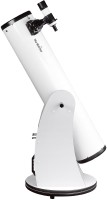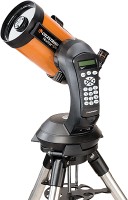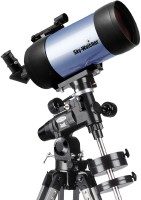Picking a telescope
When it comes to buying a telescope, I’m stumped, simply because there is no one single “best” telescope to buy. In The Backyard Astronomer’s Guide, authors Dickinson and Dyer recommend that a first-time scope be portable and simple enough that it will actually be used. I’ve narrowed it down to three candidates, each with their own pros and cons. Trouble is, Dickinson and Dyer recommend all three (or their equivalents) in their book. Picking one is proving difficult as a result: all are probably good choices, but one is probably more suitable for our needs.
The three candidates are Sky-Watcher’s Dobsonian reflector (in either the 8-inch or 10-inch versions), Celestron’s NexStar 5 SE, and Sky-Watcher’s 5-inch Maksutov.
Sky-Watcher Dobsonian Reflector (8-inch or 10-inch)
 Specifications: Newtonian reflector. Aperture: 203 mm or 254 mm. Focal length: 1200 mm. Focal ratio: f/5.9 or f/4.7. Dobsonian mount.
Specifications: Newtonian reflector. Aperture: 203 mm or 254 mm. Focal length: 1200 mm. Focal ratio: f/5.9 or f/4.7. Dobsonian mount.
Advantages: Aperture, aperture, aperture (10-inch Dob has four times the light-gathering ability of a five-inch scope) and lowest price make this the best bang-for-buck option; wide-field views; focuser accepts two-inch eyepieces; no computer technology to go obsolete; simple.
Disdvantages: Heavier (16 or 20.5 kg) and hard to move on foot; bulky to move by car; low viewing position (chair required); no photography except lunar; no tracking or go-to ability; off-axis coma and collimation issues inherent to fast Newtonian optics; comes with cheap eyepieces.
Cost: $400 (8-inch); $600 (10-inch).
Reviews: Sky-Watcher 20cm f/6 Dobsonian by Geoff Gaherty, Ottawa Valley Astronomy and Observers Group, April 2001; An Impressive New 8-Inch Dobsonian (PDF) by Terence Dickinson, SkyNews, July-August 2001.
Celestron NexStar 5 SE
 Specifications: Schmidt-Cassegrain catadioptric telescope. Aperture: 125 mm. Focal length: 1250 mm. Focal ratio: f/10. Single-arm fork mount with onboard computer.
Specifications: Schmidt-Cassegrain catadioptric telescope. Aperture: 125 mm. Focal length: 1250 mm. Focal ratio: f/10. Single-arm fork mount with onboard computer.
Advantages: When the mount is factored in, lightest option (12.5 kg) and possibly the most portable; go-to and tracking ability; ease of use; computer compatibility.
Disdvantages: Small aperture; limited wide-field views; 1¼-inch eyepieces only; telescope can’t be put on another mount; limited wide-field views; power required to operate scope.
Cost: $850 ($750 after rebate).
Reviews: Testing Two “Smart” Scopes (PDF) by Alan Dyer, SkyNews, March-April 2000, comparing an earlier version with the Meade ETX.
Sky-Watcher 127 mm Maksutov Telescope
 Specifications: Maksutov-Cassegrain catadioptric telescope. Aperture: 127 mm. Focal length: 1500 mm. Focal ratio: f/11.8. Equatorial mount and tripod.
Specifications: Maksutov-Cassegrain catadioptric telescope. Aperture: 127 mm. Focal length: 1500 mm. Focal ratio: f/11.8. Equatorial mount and tripod.
Advantages: Sharpest optics due to long focal length; light, portable telescope (3.4 kg) that can be remounted on a different tripod and mount; included mount can be used with other telescopes; best option for astrophotography.
Disdvantages: Small aperture; narrowest field; 1¼-inch eyepieces only; equatorial mount is heavy and much harder to use; adding motorized tracking and go-to ability is possible, but costs extra.
Cost: $450 (telescope only); $630 (with equatorial mount); $950 (with motorized go-to equatorial mount).
Reviews: A Compact 5-inch Telescope (PDF) by Greg Lisk, SkyNews, July-August 2005.
The Dob’s main advantages are cost, simplicity and sheer aperture: it’s also a scope that we will not likely outgrow for a while. But we can’t simply set it up in our backyard: our nearest observation site requires a walk of a couple hundred metres. That’s no easy thing with 35 to 45 pounds of telescope (in two pieces), plus whatever other accoutrements we will need (eyepieces, charts, red flashlights). The site is not road-accessible, and it’s not secure enough for multiple trips. I also have to take my illness into account: bending over is not an option, so I will need a chair to observe with this thing.
The NexStar, on the other hand, is lighter and quite possibly (need to investigate) easier to carry, which might give it the edge despite its higher cost and smaller aperture. (The rule of thumb is that portability trumps aperture because a portable scope gets used.) The Maksutov is probably out of the running, because its advantages — equatorial tracking and astrophotography — are mostly irrelevant to rank beginners like us.
Decisions, decisions.